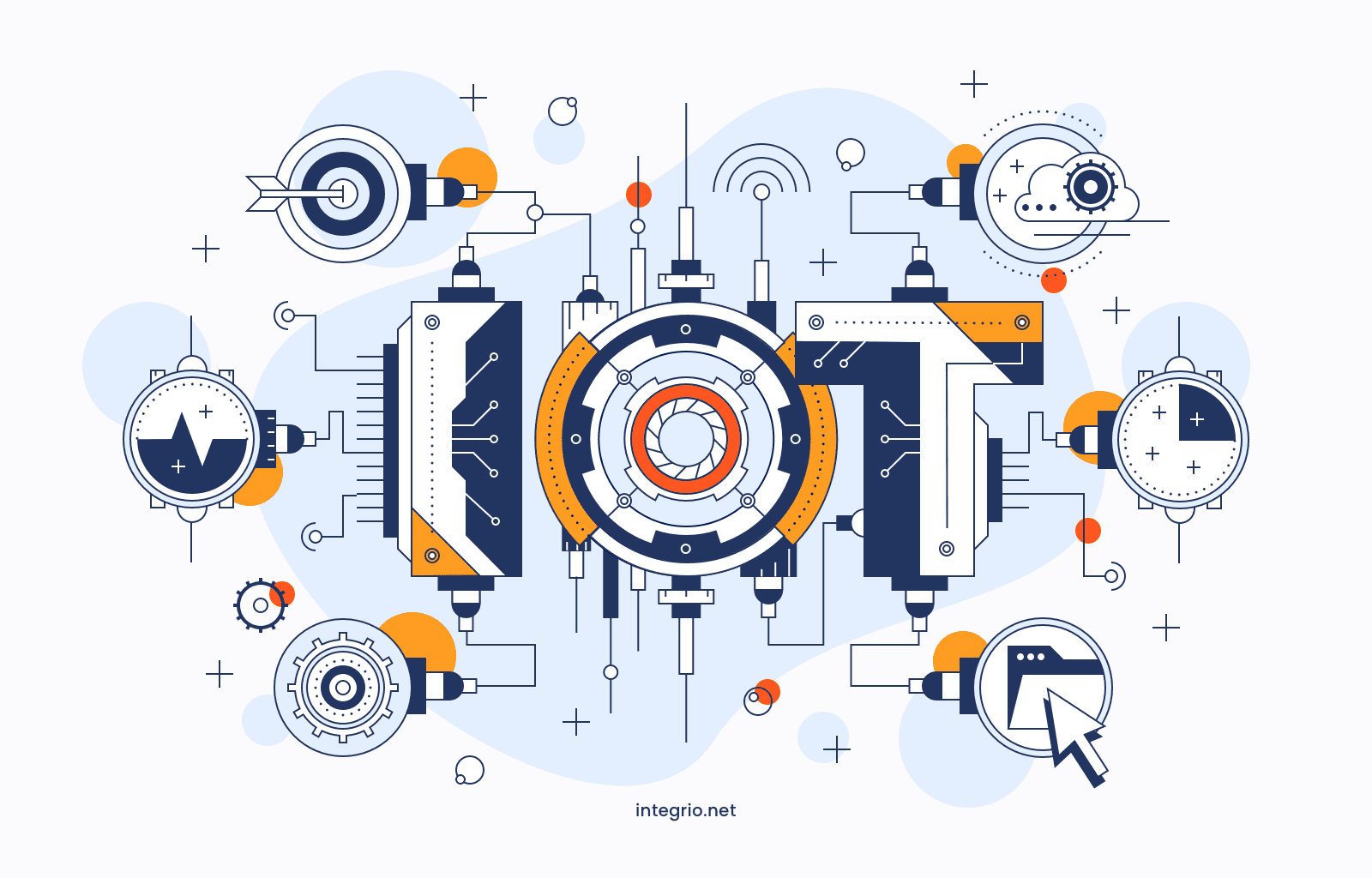Navigating the Complexities of IoT Software Development

The number of IoT devices worldwide is expected to double, reaching nearly 32.1 billion by 2030. The network of remote devices will be vast. So, there is a critical need for robust IoT software to manage and optimize these interconnected systems. As the complexity of IoT software development rises, it poses unique challenges in scalability, security, and interoperability.
In this blog post, we will explore the intricacies of Internet of Things software development, highlighting its significance in transforming industries like healthcare, manufacturing, and fintech. Keep reading to explore the best practices to navigate these challenges effectively.
Key Challenges in IoT Development
Businesses increasingly integrate IoT technologies into their operations. On this journey, they meet several challenges that might diminish the positive impact of their efforts. These intricacies arise from the complexity of managing a vast array of devices. You need to ensure compatibility among different systems and address critical security and privacy concerns.
Additionally, the volume of data on IoT devices requires effective management strategies. What’s more, network latency and connectivity issues can hinder performance. Let’s look at each challenge in more detail.
Device Heterogeneity
IoT encompasses various devices, from sensors and actuators to gateways and smart appliances, often produced by different manufacturers. This diversity can lead to issues related to compatibility, data formats, and communication protocols.
You can adopt standardized communication protocols such as MQTT or CoAP to overcome device heterogeneity. They enable seamless data exchange between devices regardless of their manufacturer. Additionally, implementing a middleware solution can help abstract device-specific details. It allows for easier integration and management of various devices in the IoT ecosystem.
This standardization is essential for businesses to ensure scalability and interoperability as they expand their IoT deployments.
Security Risks
IoT devices are often deployed in vulnerable environments, making them susceptible to cyberattacks, data breaches, and unauthorized access. The absence of encryption risks sensitive data interception and exacerbates privacy concerns. Moreover, unsecured devices can serve as entry points into broader networks. It requires regular expert testing to mitigate vulnerabilities.
Implementing end-to-end encryption, device authentication, and continuous monitoring is crucial to mitigate these risks. Regular firmware updates and expert security audits ensure that vulnerabilities are identified and addressed before they can be exploited.
Adopting a security-by-design approach during the development phase can help identify potential risks early on. Investing in advanced security solutions, such as anomaly detection systems and threat intelligence platforms, is essential for safeguarding sensitive data and maintaining customer trust.
Data Management
Vast data generated by IoT devices presents a formidable challenge for data management. Organizations need to efficiently handle and analyze large volumes of information in real time to extract actionable insights. Robust data management is essential for maximizing the benefits of IoT deployments, enabling businesses to quickly respond to market demands.
A scalable cloud-based data management solution can help you efficiently handle IoT data. Additionally, big data analytics tools can facilitate real-time data analysis, enabling you to make informed decisions quickly. By implementing efficient data management practices, you can streamline operations, reduce overhead costs, and improve overall performance.
Network Latency and Connectivity
Network latency and connectivity issues can hinder the performance of IoT applications, particularly in environments requiring real-time responses. Slow or unreliable connections can cause delays in data transmission and decision-making.
To address network latency, consider deploying a combination of wired and wireless communication technologies, such as LPWAN (Low Power Wide Area Network) for long-range communication and Wi-Fi for high-speed data transfer in local environments. Incorporating 5G technology and edge computing can further enhance connectivity—we will consider them in more detail in subsequent sections.
Reliable connectivity maintains the responsiveness and effectiveness of IoT solutions.
Best Practices for IoT Software Development
To efficiently address the complexities of Internet of Things Software Development, we recommend adopting best practices that enhance scalability, security, and performance. Here are some of them:
Modular Software Architecture
Implementing a modular approach in IoT software design is essential for achieving better scalability and easier maintenance. By breaking down the application into distinct modules, you simplify updates and modifications without disrupting the entire system.
It allows you to quickly adapt to changing requirements and scale your IoT solutions as needed, reducing time-to-market for new features and enhancing the user experience.
Security-First Development
Integrating security into the development process from the start safeguards IoT applications. This includes adopting secure coding practices, conducting regular security audits, and applying updates to patch vulnerabilities promptly.
By prioritizing security from the outset, you can significantly reduce the risk of data breaches and unauthorized access, which can lead to financial losses and damage to reputation. A proactive security approach fosters customer trust and confidence, making it easier to adopt IoT solutions in sensitive applications such as healthcare and finance.
Testing for Real-World Conditions
IoT devices are deployed in various environments, making it essential to simulate real-world conditions during testing. This involves assessing devices under unreliable network scenarios, extreme temperatures, and potential physical tampering.
By conducting rigorous testing in these conditions, you can identify potential weaknesses and ensure your IoT solutions perform reliably in the field. This practice enhances product quality and reduces the likelihood of costly recalls or post-deployment service disruptions.
Cross-Platform Development
Choosing IoT development tools and platforms that support multiple device types and communication standards is vital for interoperability and future-proofing solutions. By adopting cross-platform development strategies, you streamline development processes and reach a broader range of devices, minimizing compatibility issues.
This flexibility enables businesses to respond to market demands more effectively and reduces the need for extensive redevelopment when integrating new devices or technologies into existing systems.
Emerging Trends in IoT Software Development
Technological advancements and increasing demand for connected solutions across industries drive the Internet of Things development. As businesses seek to leverage the benefits of IoT, several emerging trends are reshaping software development practices and strategies.
Edge Computing
The global edge computing market is projected to grow from $21.41 billion in 2024 to $216.76 billion by 2032. Edge computing allows data processing to occur closer to the source of data generation. This reduces latency, improves response times, and alleviates bandwidth constraints, enabling real-time analytics and decision-making.
Businesses can utilize edge computing to improve IoT application performance, especially in scenarios requiring real-time data insights like industrial automation and smart cities.
AI and Machine Learning (ML) Integration
The AI in IoT market is expected to reach $11.77 billion by 2030. Integrating AI and ML with IoT enhances the efficiency of IoT systems by learning from historical data and making intelligent decisions through predictive analytics and automation.
It allows businesses to optimize operations, improve resource management, and enhance customer experiences through personalized services.
5G Networks
The global 5G IoT market is to reach $823.14 billion by 2032. 5G technology offers higher IoT device speeds, increased capacity, and lower latency compared to previous generations. It is crucial for applications that require real-time communication, such as autonomous vehicles and smart grids.
The widespread adoption of 5G will enable businesses to deploy advanced, previously unattainable applications and services.
Blockchain for IoT Security
The global blockchain IoT market is expected to grow to $20.94 billion by 2032. Blockchain technology in IoT software development enhances security and trust among connected devices. By providing a decentralized and tamper-proof method for recording transactions, blockchain can help secure data exchanges and verify device identities.
This technology is particularly valuable for industries that require high levels of security, such as healthcare, finance, and supply chain management. Blockchain ensures that IoT systems are resilient against cyber threats.
Examples of Successful IoT Software Development
The Internet of Things (IoT) has made significant strides across various industries, driving innovation and efficiency. Here are examples of successful IoT solutions from the manufacturing, fintech, and transportation sectors.
Manufacturing: Siemens MindSphere (Insights Hub)
Siemens has developed MindSphere (now Insights Hub), an IoT operating system that connects industrial machines and systems to the cloud. It enables manufacturers to harness data for insights and optimization.
With features like real-time monitoring and predictive maintenance, MindSphere helps companies reduce downtime, improve efficiency, and lower operational costs. By integrating IoT data with advanced analytics, manufacturers can make informed decisions that drive productivity.
Read more about industrial IoT in our blog.
Fintech: Zeta
Zeta offers a cloud-native banking platform that leverages IoT technology to enhance customer engagement and streamline financial services. Using connected hardware, such as wearables, Zeta allows users to access their accounts, make transactions, and manage finances seamlessly.
The platform also employs real-time data analytics to deliver personalized financial insights, improving customer satisfaction and driving loyalty in a competitive market.
Transportation: Geotab
Geotab is a leading provider of IoT-based fleet management solutions that help businesses optimize their transportation operations. By equipping vehicles with connected devices, Geotab collects and analyzes data on vehicle performance, driver behavior, and fuel consumption. This information enables fleet managers to make data-driven decisions that enhance efficiency, reduce costs, and improve safety.
With features like route optimization and maintenance alerts, Geotab helps companies maximize their fleet's potential.
Ace IoT Software Development with Integrio
If you want to harness the power of interconnected devices, skillful navigation of the complexities of IoT software development is inevitable. Implementing best practices, such as modular architecture, security-first development, and testing under real-world conditions, can streamline the development process and enhance the reliability of IoT solutions. Moreover, staying abreast of trends will help you remain competitive and responsive to market demands.
At Integrio, we leverage over 20 years of experience in web development to help businesses optimize their processes and innovate effectively. Our dedicated developers combine deep technical expertise in AI & ML, cloud solutions, and full-cycle enterprise software development.
Contact us to master your IoT software development initiatives and drive business success.
Contact us

